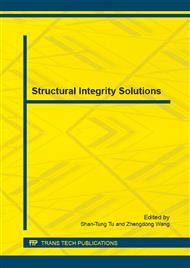p.24
p.32
p.41
p.47
p.51
p.59
p.69
p.76
p.79
Trans-Scale Analysis Approach of Fatigue Crack Behavior for Aluminum Alloy LC4 Plate
Abstract:
Material damage state is described by a restraining stress zone. Then, a macro/micro trans- scale fatigue crack growth model is established. The proposed model is used to simulate the whole fatigue process from a micro-defect to the final macroscopic fracture. Numerical calculations are performed. The fatigue test data for the LC4 aluminum alloy plate specimens are accurately re-produced by the present model. Furthermore, when the microscopic effects are taken into account, the scatter feature of the fatigue test data can also be reflected.
Info:
Periodical:
Pages:
51-58
Citation:
Online since:
April 2015
Authors:
Price:
Сopyright:
© 2015 Trans Tech Publications Ltd. All Rights Reserved
Share:
Citation:


